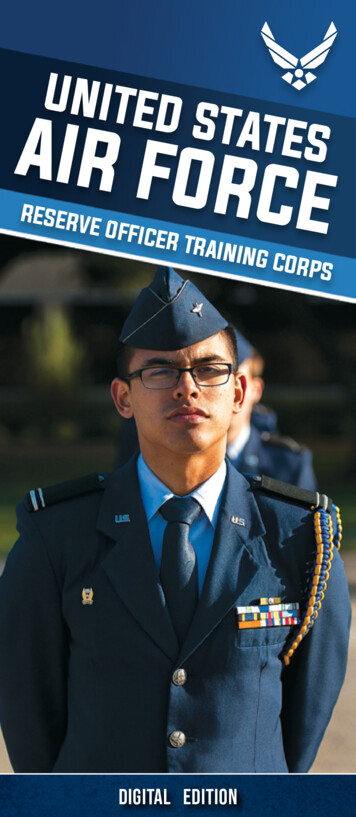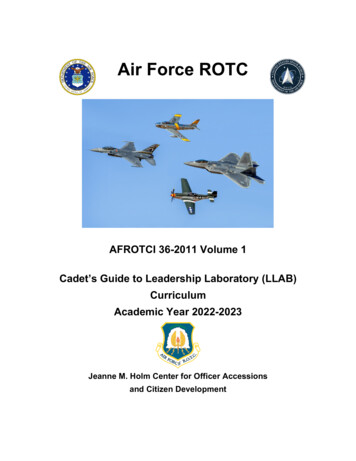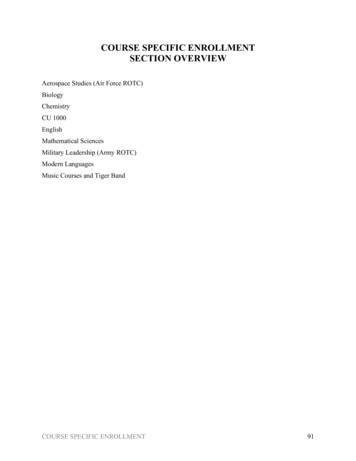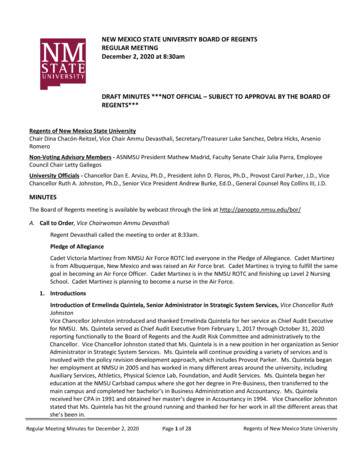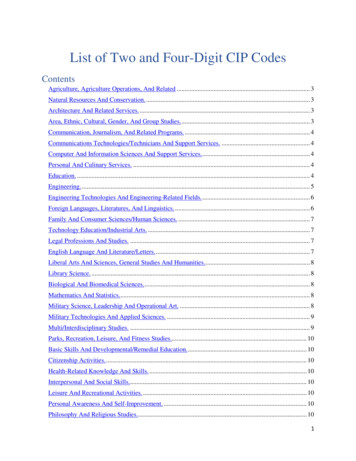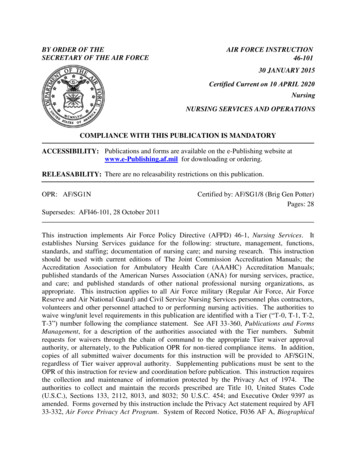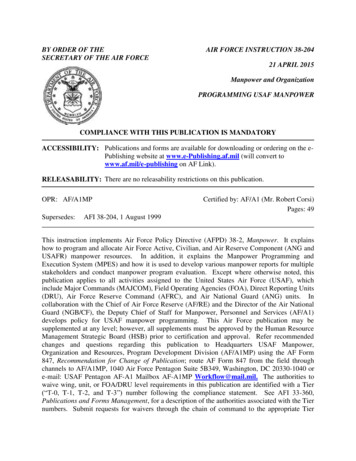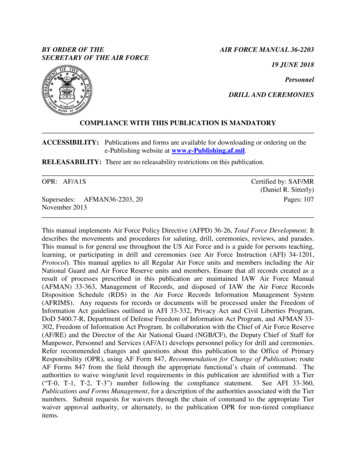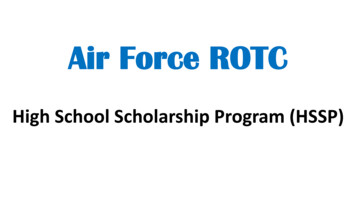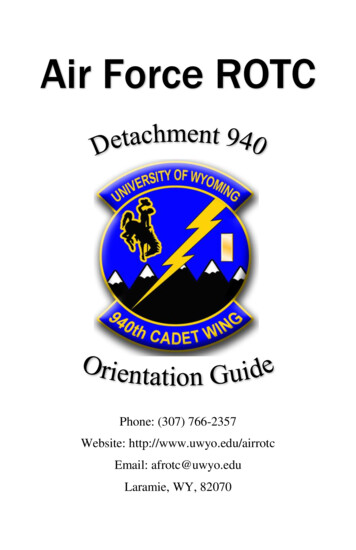
Transcription
Air Force ROTCPhone: (307) 766-2357Website: http://www.uwyo.edu/airrotcEmail: afrotc@uwyo.eduLaramie, WY, 82070
Welcome!Hello and welcome to the AirForce ROTC Program at theUniversity of Wyoming! From theCadre and Cadets here atDetachment 940, we are excitedthat you are here and taking thefirst step towards becoming a partof the world’s greatest Air Force!OverviewThe Reserve Officer Training Program is designed to enhance yourleadership skills and prepare you for a career as an Active Dutyofficer in the United States Air Force. Throughout your time you willface challenges, have valuable and rewarding experience, and formconnections and friendships that will last a lifetime.In this packet you will find information and tips to help prepare youto be a new, 1st year cadet. If you have any questions, do not hesitateto reach out.
Meet the CadreDetachmentCommander:Lt. ColonelKusekAssoc.ProfessorLt. ColonelShearerOperations Flt.CommanderMajorLandsverkRecruitingOfficerMajor DaughertyPersonnel:Staff SergeantMontezPersonnel:Tech. SergeantGianniniUW-AFROTCLiaison:Vacant
Places/Buildings to KnowA) AFROTC is found in Hill Hall. This is where all cadre reside.Cadet office space is also available including a free computer lab.B) The John Corbett Building will be the main location forLeadership Lab. This is also another location for Physical Training(PT) sessions.C) The Field House will be another frequently visited building. Thisis where most PT will occur.D) Half Acres is the main gym on campus. This is another locationfor PT.E) Prexy’s Pasture is our main outdoor fitness area.
What to ExpectPTWe have Physical Training(PT) every week, 2 days aweek. It is held Tuesdays andThursdays from 0545-0645.You will be notified each weekof the exercise and location.You will be tested once asemester via the Air ForcePhysical Fitness Assessment: 1min of push-ups, 1 min of situps, a 1.5-mile run, waistmeasurement, andheight/weight.Your fitness is also consideredwhen applying for scholarships,qualifying for awards, andcompeting for certain jobswhen you commission.Tip: ROTC does a great job at maintaining physical fitness, but it isalways a good idea to fit in workouts of your own throughout theweek, especially on the weekends.
LLABOn Wednesdays from 1510-1700, you will attend LeadershipLab (LLAB). First and second-year cadets spend this timelearning and applying leadership skills, listening to experiencesfrom officers, enlisted personnel and other speakers, learning tomarch, practicing problem-solving skills, working as a team,and learning Air Force customs and courtesies. An alternatetime will be made available for those with schedule conflicts.What to bring: A pencil/pen, notebook, and water bottle. Theuniform of the day (UOD) will be described in the weeklyOperation Order (OPORD).Tip: Once you are on the email list, a detailed schedule of eachweek’s events, called an Operations Order (OPORD), will be sent outthe weekend prior. Check your email often. It is a good idea to printit out or write down important information from it. It will also beposted in Hill Hall.
ClassThe classes you will take the first two years in the program areonly one credit hour - you meet once a week for 75 minutes.The first-year class focuses on “Air Force & Space Force 101:”introducing you to the United States Air Force & Space Forceand ROTC, discussing our structure, Air Force & Space Forcecapabilities, career opportunities, benefits, core values, teambuilding, and communication skills. The second-year classfocuses on leadership fundamentals. You will learn how tocommunicate the Air Force & Space Force way, throughlearning how to brief and write items like Memorandums forRecord (MFRs) and Bullet Background Papers (BBPs). As anupperclassman, the class increases to 3 credit hours. Thesecourses allow you to hone your leadership and officer-shipskills and prepare you for active duty as an officer.
FAQQ: What grades do I need to maintain to participate?A: All cadets must maintain a 2.0 cumulative GPA. Cadets onscholarship must maintain a 2.5 cumulative and term GPA. YourGPA is evaluated during several ‘checkpoints’ during your cadetcareer (Field Training application, career field application, etc.) andeach semester. The expectation is that you are a student first. Whilethese are minimum requirements, it will serve you well to maintain amuch higher GPA. A higher GPA leaves many doors open for you asa college student and cadet.Our Detachment’s current average GPA is 3.39.Q: Can I get a scholarship?A: If you are not on scholarship out of high school, you can competefor scholarships the spring semester of your first year and the fallsemester of your second year in the program. There are multiple typesof scholarships, each with different criteria. All scholarships require aminimum of 3.0 cumulative GPA and 2.5 term GPA to apply. If youwant to learn more specifics about in-college scholarships, email ourRecruiting Officer, Major Daugherty, tdaugher@uwyo.edu or Mrs.Miller, tmille75@uwyo.edu with questions or to set up a meeting.Q: Do I attend Basic Training?A: No, cadets do not attend Basic Military Training. However, allcadets must go through Field Training (FT) as part of a 4-yearcurriculum. FT has evolved into a two-week training and evaluationcourse that you usually attend the summer between your sophomoreand junior year.
Helpful InformationEmailing: Emailing is the primary way you will receiveinformation for ROTC; it is recommended that you check youremail at least twice a day: early morning and later in the day. Itis a general rule to respond to emails within 24 hours. Only useyour school email for communication. Refer to the followingexample when sending or replying to an email.Tip: You can create an email signature block in Outlook thatwill attach to all emails you send. You will want to includeyour signature for all ROTC emails.
Ways to PrepareFitnessDoing pushups, sit ups, and running regularly will help youprepare you for PT and our fitness test. Fitness test criteria andscoring are below.
LeadershipEssential traits of leadership can be found throughout selectionsfrom The Chief of Staff of the Air Force Reading List atwww.static.dma.mil/usaf/csafreadinglist/.
Basic GroomingHair will be neat, well-groomed, and present a professionalimage. Hair must not contain excessive amounts of groomingaids, touch either eyebrow when groomed, and it must beallowed for proper wear of headgear.Females: Hair will not exceed 3 inches in bulk and cannottouch the eyebrows and cannot extend past the bottom edge ofthe collar. Hair will be pinned up in a way that prevents looseends from extending outwards of the head. Hairpins, combs,headbands, elastic bands, and barrettes may be worn and mustbe conservative in color and match hair color. Ornaments andscrunches are not authorized.While in PT gear, longer hair will be secured but may haveloose ends and can extend below the collar (ponytails).
Males: Hair cannot exceed 1 ¼ inches in bulk and must nottouch ears or collar. Mustaches are authorized and must notextend below the upper lip or outside of a vertical line drawnup-wards from the corners of the mouth.Jewelry: A maximum of three rings combined on both handsmay be worn at a time. Watches and bracelets must beconservative in color and not present a safety hazard. Males arenot authorized to wear earrings. Females may wear one earringin each ear, and they must be small (no more than 6mm indiameter). Earrings must be conservative, round, or square whitediamond, gold, white pearl, or silver earrings.Cosmetics: Males are not allowed to wear cosmetics. Femalesare authorized to wear cosmetics conservatively and in goodtaste. Extreme colors of lipstick that detract from the uniformare not authorized. Cosmetics are not authorized during fieldconditions. Any nail polish worn must be conservative. Solid,non-extreme colors that do not largely differ from member’scomplexion, nor detract from the uniform, are authorized.
Useful AcronymsABU - Airman Battle UniformAFOQT - Air Force Officer Qualifying TestAFROTC - Air Force Officer TrainingCorpsAF - Air ForceAFSC - Air Force Specialty Code (This isyour job designation)AAS - Arnold Air SocietyCAP - Civil Air PatrolCPO - Chief Procurement OfficerDoD - Department of DefenseDODMERB - Department of DefenseMedical Examination Review BoardGMC - General Military Course (AS100,AS200, AS250)ICSP - In-College Scholarship ProgramJAG - Judge Advocate General (This isbasically a military lawyer)LEAD - Leadership Evaluation andDevelopment (formerly Field Training)LEADP - LEAD PrepNCO - Non-Commissioned OfficerPT - Physical TrainingPFA - Personal Fitness AssessmentPFT - Physical Fitness TestPOC - Professional Officer Course (AS300, AS400, AS500, AS700, AS800)USAFA - United States Air ForceAcademyUSAF - United States Air Force
Ranks of the Air Force
The first-year class focuses on "Air Force & Space Force 101:" introducing you to the United States Air Force & Space Force and ROTC, discussing our structure, Air Force & Space Force capabilities, career opportunities, benefits, core values, team building, and communication skills. The second-year class focuses on leadership fundamentals.
